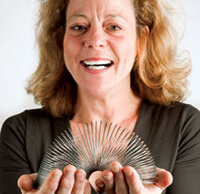Keep in Touch
Professor studies why, for some, only fingers can do the shopping.

Joann Peck. Photo: Bryce Richter
Joann Peck MBA’93 has spied on people in grocery stores, and her office is sprinkled with Slinkys, Koosh Balls, and chenille blankets. It’s all in the name of research for Peck, a marketing professor in the Wisconsin School of Business who studies the role of touch in consumer behavior.
Peck has developed what she calls a need-for-touch scale, which measures the difference between people who can’t walk through a store without handling everything within reach and those who only grab what they are actually going to buy. Her work is increasingly relevant with the growing popularity of online shopping, as retailers seek ways to get people to buy, even when the description of a sweater as “soft” just isn’t enough.
Peck’s scale reveals why people want to touch products. For some, it’s spontaneous and strictly for fun. For others, it’s driven by a need to know something specific about a product, such as how heavy a laptop computer would be to carry around.
About 25 percent of people have an extremely high need for touch, yet when shopping online, sometimes a description — say the weight of a cell phone — is all they need, Peck says. With items such as books and CDs, most people don’t care if they get to touch the product, but “if it’s something fun to touch, there isn’t really a way I’ve found to compensate people,” she says.
Her latest research shows that touching an object increases a person’s sense of ownership, a finding that could have a major impact on new-product development. “You’re willing to pay more if you feel more ownership, which also has really interesting implications for marketing,” Peck says.
Published in the Spring 2009 issue



Comments
No comments posted yet.